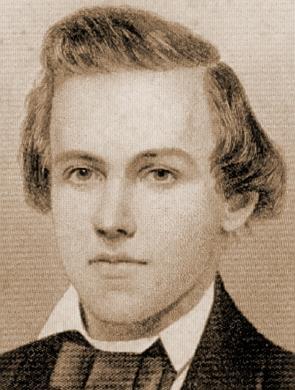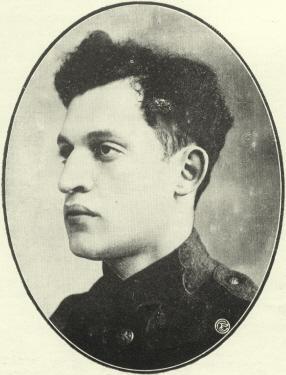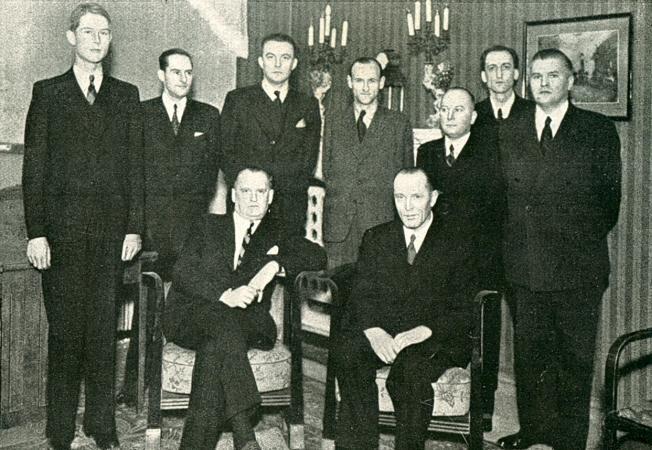
Edward Winter
Page 144 of 2010 Chess Oddities by Alex Dunne (Davenport, 2003) condensed Morphy’s life into half a page but still found space to assert, ‘he arranged women’s shoes in a semicircle around his bed’.
The Morphy/shoes story was discussed on page 305 of David Lawson’s biography of Morphy and on page 162 of Chess Explorations. Over the years much embroidery (e.g. ‘women’s shoes’) has been grafted onto what appeared in the earliest known sighting of the Great Morphy Footgear Affair (i.e. on page 38 of the 1926 booklet Life of Paul Morphy in the Vieux Carré of New-Orleans and Abroad by Regina Morphy-Voitier). Morphy’s niece wrote:
‘Now we come to the room which Paul Morphy occupied, and which was separated from his mother’s by a narrow hall. Morphy’s room was always kept in perfect order, for he was very particular and neat, yet this room had a peculiar aspect and at once struck the visitor as such, for Morphy had a dozen or more pairs of shoes of all kinds which he insisted in keeping arranged in a semi-circle in the middle of the room, explaining with his sarcastic smile that in this way, he could at once lay his hands on the particular pair he desired to wear. In a huge porte-manteau he kept all his clothes which were at all times neatly pressed and creased.’
This innocently unenthralling story (about how Morphy arranged his own shoes) subsequently passed through many hands, such as Reuben Fine’s (The Psychology of the Chess Player, page 38):
‘... another eccentric habit of arranging women’s shoes in a semi-circle in his room. When asked why he liked to arrange the shoes in this way he said: “I like to look at them”.’
On page 16 of Idle Passion (New York, 1974) Alexander Cockburn declared that Morphy died ‘according to some accounts, in his bath, surrounded by women’s shoes’.
In Time, 17 February 1975 Brad Darrach wrote:
‘Paul Morphy he [Cockburn] reminds us, was a paranoid fetishist … who liked to stand ecstatically in a circle of women’s shoes.’
And so it is that much of chess history is not history at all but lurid figments. Anyone criticizing such output risks being labelled a spoilsport or humourless pedant, but a far heavier price is paid by our game’s greatest practitioners, for they are condemned to star ad infinitum in seedy anecdotes which are the product of mindless inter-hack copying or brutal distortion. Any aspect of their lives is considered fair game for sheep and jackals alike, this being the time-honoured process whereby chess history is made ‘fun’.

Paul Morphy
(2913)
C.N. 5280 discussed Treasure Chess by Bruce Pandolfini (New York, 2007) and quoted from page 264:
‘Paul Morphy did various inexplicable things, such as placing women’s shoes in a semicircle around his bed before going to sleep.’
From page 79 of the 2002 edition of Chess Lists by A. Soltis:
‘The most tragic case belongs to Paulino Frydman, a little-known Polish master who was invited to the Bad Podĕbrady, Czechoslovakia international of July 1936. Surrounded by several world-class players – including Alexander Alekhine, Salo Flohr, Erich Eliskases and Gideon Stahlberg – he astounded them by allowing only a draw in his first seven games. But two rounds later, with a score of 8-1, he lost to Alekhine and suffered a nervous breakdown. Frydman scored only one and a half points in his last eight games and finished as an also-ran. He was never again a significant figure in chess.’
There were similar words from Sourceless Soltis on page 81 of the 1984 edition of his book. In reality, though, from the field of 18 masters Frydman finished equal sixth with Eliskases, and his significant over-the-board achievements in subsequent years are a matter of public record. As regards the ‘nervous breakdown’ part of the story, it may be wondered if Soltis had any solid information of his own or was merely copying from Wolfgang Heidenfeld’s entry on the Podĕbrady tournament in The Encyclopedia of Chess by Harry Golombek (London, 1977).
Next, a typical Internet item by Bill Wall:
‘Frydman, Paulino (1905-1982)
A leading Polish player during the 1930s who represented his country in seven Olympiads. He used to run around nude in hotels yelling, “fire”.’
Wall writes similarly at another website:
‘Paulino Frydman was a leading Polish player during the 1930s who represented his country in seven olympiads. He used to run around nude in hotels yelling “fire”.’
Or again:
‘The Polish master Frydman also ran around nude, but usually in hotels while yelling, “fire”.’
At yet another Internet site, Wall disseminates a slightly dressed-up version of his story:
‘The Polish master Paulino Frydman represented his country in seven chess olympiads. He liked to clear out hotels by running down the halls in his underwear yelling, “Fire!”’
At no stage, of course, has Wall given any further particulars, but a similar tale may be recalled from The Psychology of the Chess Player by Reuben Fine. On page 65 he wrote:
‘During a chess tournament in Poland a Polish master by the name of A. Frydman was reported to have gone berserk and to have run through the hotel without any clothes on shouting “Fire!”’
This may seem strange. We have been repeatedly assured by Wall that the master in question was Paulino Frydman, so why did Fine write ‘A. Frydman’? Moreover, Fine suggests that the incident in question occurred once only, whereas Wall is ostensibly privy to information that it was Frydman’s frequent conduct (i.e. what he ‘used to’ do, ‘liked to’ do and ‘usually’ did). Finally, given that Podĕbrady was in Czechoslovakia and not Poland, where Fine places the tournament in question, how might any of this tie in with Soltis’ reportage?
We note that page 44 of CHESS, 14 October 1937 contained the following piece under the heading ‘What really happened?’:
‘Variations of the following weird theme have appeared in a number of British and American newspapers. We reproduce without comment:
“In a chess tournament at Jurata, Poland, a contestant, Willy Frydmann, lost a game then went raving mad.”’
So now we have ‘Frydmann’ instead of ‘Frydman’ and ‘Willy’ rather than either ‘Paulino’ or ‘A’.
Pages 197-198 of the July 1937 Deutsche Schachzeitung had a brief account of the Jurata tournament, a 22-man contest in May/June for the Polish championship. It was won by Tartakower ahead of Ståhlberg and Najdorf, and the Deutsche Schachzeitung stated that P. Frydman finished last but two, with 6½ points, having withdrawn after losing in the 15th round and suffering a nervous breakdown. (‘Frydman erlitt, als er in der 15. Runde verlor, einen Nervenzusammenbruch und musste aus dem Turnier ausscheiden.’)
However, the full crosstable of Jurata, 1937 was given on page 374 of the December 1937 Wiener Schachzeitung, and it stated, correctly, that the player who finished 20th was A. Frydman. Earlier (page 152 of the May 1937 issue) the Wiener Schachzeitung had named the player as Achill Frydman and had referred to ‘den tragischen Unfall Achill Frydmans, der mit einer schweren Nervenerkrankung in eine Heilanstalt überführt werden musste’.
Jeremy Gaige’s Chess Personalia lists ‘Achilles Frydman (1905-circa 1940)’, a player with an entry on page 276 of Szachy od A do Z by W. Litmanowicz and J. Giżycki (Warsaw, 1986). Perhaps a Polish correspondent can locate further details. And perhaps – a true long shot, this – one or two writers will consider it appropriate to substantiate their assertions about Paulino Frydman. For our part, we have found no contemporary report mentioning fire, nudity or underwear.
(2917)
From Tomasz Lissowski (Warsaw):
‘It is true that Achilles Frydman of Łódź (and not the more famous Paulin(o) Frydman of Warsaw, and later of Buenos Aires) had serious health problems in the late 1930s. Two quotations follow, the first being from the column in Polska Zbrojna by Colonel M. Steifer at the time of the Jurata, 1937 tournament:
“Najdorf could have easily won first prize, had it not been for an irritating incident with A. Frydman, who caused many difficulties for the tournament management and for the players. This cost Najdorf two points: the games he lost against Gerstenfeld and Schächter in winning positions.”
Further information is given by Tadeusz Wolsza on page 32 of the third volume of his dictionary of Polish chess players, Arcymistrzowie, mistrzowie, amatorzy (Warsaw, 1999):
“Near the end of the tournament Achilles Frydman fell ill. After one of his numerous lost games he was the victim of a strong attack of fury, and doctors placed him in a mental asylum in Kocborowo. This unfortunate case ended his chess career. He never returned to competitive chess, and his occasional off-hand games were only against friends.”’
(2932)
Christian Sánchez (Rosario, Argentina) refers us to page 10 of the eighth issue of the Spanish magazine Ocho x Ocho Especial (January 1995), in which Román Torán quoted Albéric O’Kelly de Galway as stating that at Łódź, 1938 ‘Friedman’, entirely naked, turned up 15 minutes late for his game against Tartakower. It is not specified where the Belgian master wrote the item attributed to him by Torán.
(3290)

George Koltanowski
Now we add the handling of the affair by Koltanowski, from an article entitled ‘People are the craziest!?’ on page 186 of Chess Digest Magazine, August 1971:
‘[L]et me start at the beginning of this true story:
We quote from the Jurata (Poland) morning paper of 11 August 1937:
“In the International Chess tournament of Jurata, 21 of the 22 competitors have suddenly become stark crazy. They have decided to continue with the tournament and finish their 21 games in 14 days. Only one participant was sensible enough to retire to a resthome.” End quote.
The player in question was Anton Frydman, a Pole who a few days before the start of the tournament, had just been released from a Mental Institute and had been warned by the doctors not to play chess for a good while. Yet Frydman persuaded the tournament organizers to allow him to play in the tournament. In the first rounds he played good chess. He managed to draw with Xavier Tartakower, who eventually won the tournament. But the way the chess masters played, NO adjournments, playing two games a day, almost each day, with a total of 12 to 14 hours of mental work daily, sometimes even longer, something had to give.
In the 12th round Frydman started his shenennigans [sic]! During his game with Miguel Najdorf, Frydman ran to the phone after every move, placing long-distance calls collect, ordering such important articles as a bicycle from Germany, a flute from Hungary, etc. The next day he had to be locked up in his room ... he insisted in walking around in the lobby in his Adam’s suit. Gideon Stahlberg, who had the misfortune of having the room next to Frydman, couldn’t sleep at night. His (opponent) next-door neighbor was calling out check and check-mate all night long in a very loud voice.
That was when the committee decided to have Frydman returned to his Resthome ... and the players met to vote if they should continue the tourney under those terrible long hour conditions. They finished the event!’
The ellipses in the above passage are Koltanowski’s.
What he terms ‘this true story’ is just a further example of the Koltanowski drivel-machine at full throttle. He did not participate in the tournament, and the origin of many of his claims is unknown to us. A number of them, however, are contradicted by the details in Four Polish Championships by T. Lissowski (Nottingham, 2003), which gives all available games from Jurata, 1937 and some background information (noting, for instance, that the tournament took place from 23 May to 6 June 1937 and that ‘three games were to be played every two days’). The following points, in particular, may be listed:
a) Although the tournament finished on 6 June, Koltanowski claims to be quoting a topical-sounding newspaper item which he dates over two months later: 11 August 1937. (It may seem ungracious to criticize Koltanowski on a matter where, for once, he attempted to cite a documentary source, but he failed even to name ‘the Jurata (Poland) morning paper of 11 August 1937’ from which he was purportedly quoting.)
b) Koltanowski refers to ‘Anton’ Frydman. His forename was Achilles.
c) Another incorrect statement by Koltanowski is that Frydman drew with Tartakower. In fact, Tartakower won (in round 2).
d) Koltanowski is also wrong to indicate that Frydman’s game against Najdorf was in the 12th round. They met in round 15.
e) Nothing has been found to support Koltanowski’s assertions about Frydman’s withdrawal from the tournament.
(3567)
In 1976 Paul Schmidt wrote to Chess Life & Review to straighten out the following paragraph by Koltanowski which had appeared on page 89 of the February 1976 issue:
‘During the Second World War Dr Alexander Alekhine, then Champion of the World, participated in a number of tournaments. In 1942 he played in Prague, under the sponsorship of Germany’s Nazi Youth Association. There he met 18-year-old Klaus Junge of Leipzig, who was acclaimed as a future world champion by the German press, and who was stabbed to death in a chess club fight in 1942!’
On pages 212-213 of the April 1976 issue Schmidt wrote:
‘Klaus Junge, one of my best friends, was not “stabbed to death in a political brawl in a chess club in 1942” as stated by George Koltanowski in the February issue. He died in combat, as a German officer, on the last day but one [sic] of World War II, i.e. in 1945. Nor did Alekhine meet him for the first time at the tournament in Prague, 1942, where they tied for first and second place. They met for the first time at the 1941 tournament in Warsaw-Cracow, their individual game ending in a draw, … and then again in 1942 at the six-master double-round tournament in Salzburg, each winning one game… [as well as two other tournaments before Prague, 1942].
Klaus Junge also did not come from Leipzig. He was born in Chile as the son of German parents who, unfortunately, returned to Germany to get a better education for their children than was possible at that time in Chile – only to lose all their three sons to Hitler’s war. His parents lived in Hamburg.
About the only correct reference to Klaus Junge in Mr Koltanowski’s article is to his chess genius: had he not died in 1945 he would indeed have become a formidable contender for the world championship. He was equally fond of combinatorial and positional play, and his style was completely mature even at age 18. My book Schachmeister Denken! (Walter Rau Verlag, 1949) is dedicated to the memory of Klaus Junge.’

Photograph in the Prague, 1942 tournament book. Standing: K. Junge, J. Podgorný, J. Foltys, F. Sämisch, J. Rejfíř, C. Kende (organizer), F. Prokop. Seated: A. Alekhine, O. Důras.
(2926)
To the Chess Notes main page.
To the Archives for other feature articles.
Copyright: Edward Winter. All rights reserved.